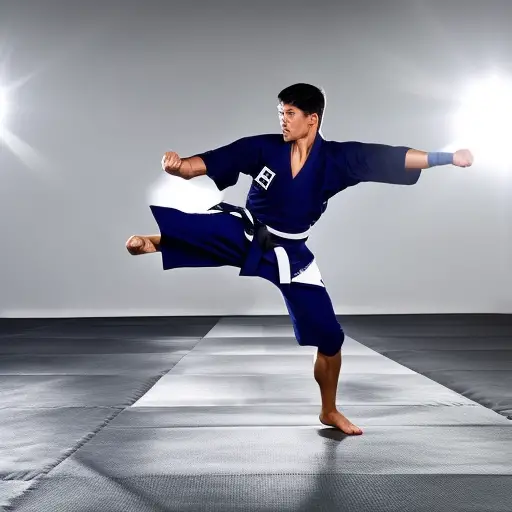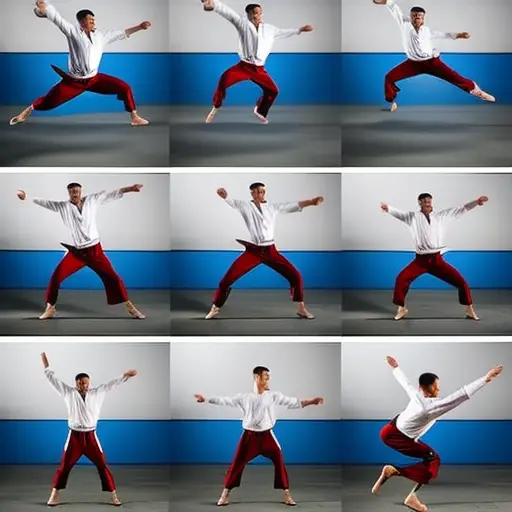Taekwondo Defense Techniques

While many may view taekwondo as a solely offensive martial art, it is important to recognize the significance and effectiveness of its defense techniques.
In this article, we will delve into the world of taekwondo defense techniques, exploring basic blocks, advanced dodges, counterattacks and strikes, joint locks and grappling techniques, as well as defense against weapons.
With a knowledgeable, organized, and practical approach, we aim to equip practitioners with the skills necessary to protect themselves and others in various situations.
Basic Blocks
One must understand the importance of mastering basic blocks in Taekwondo defense techniques. Basic blocks are fundamental components of a strong defense and form the building blocks for more advanced techniques. They are used to deflect or neutralize incoming attacks, keeping the practitioner safe and in control of the situation.
Different stances play a crucial role in executing effective blocks. The most common stances used in Taekwondo include the forward stance, back stance, and horse riding stance. Each stance provides stability and balance, enabling the practitioner to generate power and execute blocks with precision.
Effective footwork is another key aspect of mastering basic blocks. Being able to move quickly and efficiently allows the practitioner to position themselves correctly to intercept and block incoming attacks. Proper weight distribution and foot placement are essential for maintaining stability and generating power in the blocks.
Practicing basic blocks regularly helps to develop muscle memory and reflexes, allowing the practitioner to react instinctively in self-defense situations. It also enhances coordination, focus, and timing, all of which are crucial for effective defense in Taekwondo.
Advanced Dodges
The practitioner must master advanced dodges in order to effectively evade and counter incoming attacks in Taekwondo defense techniques. Advanced footwork and tactical evasion techniques play a crucial role in enhancing the defender’s ability to avoid strikes and create openings for counterattacks.
In advanced dodges, footwork becomes more intricate and precise. The practitioner must be able to move swiftly and change directions seamlessly to confuse the opponent. Techniques such as the side step, pivot, and shuffle are commonly used to evade attacks while maintaining balance and stability. The ability to combine these footwork techniques with upper body movements is essential in creating an effective dodge.
Tactical evasion techniques involve using body movements to avoid strikes. These techniques include slipping, ducking, and weaving. Slipping involves moving the head and upper body out of the line of attack, while ducking requires the practitioner to lower their center of gravity to avoid high strikes. Weaving, on the other hand, involves moving the entire body in a fluid motion to evade attacks from different angles.
Mastering advanced dodges in Taekwondo defense techniques allows the practitioner to effectively evade incoming attacks and create opportunities for counterattacks and strikes. By evading strikes with precise footwork and tactical evasion techniques, the defender can quickly transition into offensive moves, catching the opponent off guard.
In the next section, we will explore the importance of counterattacks and strikes in Taekwondo defense techniques.
Counterattacks and Strikes
To effectively neutralize an opponent’s attack and regain control of the situation, taekwondo practitioners utilize counterattacks and strikes in their defense techniques. Counterattacks are designed to swiftly respond to an opponent’s attack, redirecting their energy and creating an opportunity for a successful strike. Taekwondo practitioners are trained in various counterattacking techniques that allow them to effectively defend themselves while simultaneously launching a powerful attack. These techniques require precise timing, accuracy, and the ability to read an opponent’s movements.
In order to execute counterattacks effectively, taekwondo practitioners must develop specific sparring strategies. These strategies involve studying an opponent’s patterns and tendencies, and then utilizing counterattacks that exploit their weaknesses. By analyzing an opponent’s techniques and predicting their movements, practitioners can launch swift and unexpected counterattacks that catch their opponent off guard.
Speed and agility training are crucial for mastering counterattacks and strikes in taekwondo. Quick reflexes and agility allow practitioners to swiftly evade an opponent’s attack and swiftly strike back. By incorporating drills and exercises that focus on improving speed and agility, taekwondo practitioners can enhance their ability to execute counterattacks with precision and power.
Transitioning into the subsequent section about ‘joint locks and grappling techniques’, taekwondo practitioners also learn how to immobilize and control an opponent through joint locks and grappling techniques. These techniques are utilized when counterattacks and strikes alone are not sufficient to subdue an opponent. By seamlessly transitioning from counterattacks to joint locks and grappling techniques, taekwondo practitioners have a comprehensive arsenal of defensive techniques at their disposal.
Joint Locks and Grappling Techniques
Transitioning seamlessly from counterattacks to joint locks and grappling techniques allows taekwondo practitioners to effectively immobilize and control their opponents in close-quarters combat. Joint locks are essential submission holds that can be applied to various joints in the body, such as the wrist, elbow, or shoulder, to cause pain and restrict movement. These techniques are particularly useful when an opponent tries to grab or hold onto the practitioner.
Grappling techniques are equally important in taekwondo, especially in ground fighting situations. Ground fighting refers to when the combatants are on the ground, and these techniques enable the practitioner to maintain control and gain an advantage over their opponent. By utilizing techniques like sweeps, throws, and pins, taekwondo practitioners can neutralize their adversary’s movements and establish dominant positions.
One such grappling technique commonly used in taekwondo is the armbar. This technique involves immobilizing the opponent’s arm by hyperextending their elbow joint, forcing them to submit or risk injury. Another effective technique is the triangle choke, where the practitioner uses their legs to lock the opponent’s head and arm, cutting off their blood flow and air supply.
Defense Against Weapons
Incorporating proper techniques and strategies, taekwondo practitioners can effectively defend against weapons using their agility and precise movements. When facing a threat involving firearms or bladed weapons, taekwondo practitioners rely on their training to neutralize the danger. Here are three key strategies used in taekwondo for defense against weapons:
-
Evasion and Distance Control: Taekwondo practitioners are trained to quickly assess the situation and create distance between themselves and the attacker. By utilizing their agility and footwork, they can evade incoming attacks and maintain a safe distance, reducing the effectiveness of the weapon.
-
Redirecting and Disarming: Taekwondo emphasizes redirecting the force of an attack rather than meeting it head-on. When faced with an armed attacker, practitioners use their precise movements to redirect the weapon away from their body, creating an opportunity for disarming and rendering the attacker defenseless.
-
Targeting Vulnerable Areas: Taekwondo practitioners are trained to target vulnerable areas on the attacker’s body, regardless of the weapon they possess. By striking pressure points or sensitive areas such as joints or eyes, practitioners can incapacitate the attacker and gain control of the situation.
Frequently Asked Questions
How Long Does It Take to Master the Basic Blocks in Taekwondo?
Mastering basic blocks in any martial art discipline, including Taekwondo, requires a significant amount of time and effort. It is a process that can take several years to achieve, depending on an individual’s dedication and consistency in practice.
Are There Any Specific Techniques That Can Be Used to Counter an Opponent’s Counterattack?
When facing an opponent’s counterattack, it is crucial to employ effective counterattacking techniques. These techniques, such as redirection, evasion, and timing, can be utilized to neutralize the opponent’s attack and regain control of the situation.
Can Joint Locks and Grappling Techniques Be Used Effectively in Self-Defense Situations?
Grappling techniques, including joint locks, can be effective in self-defense situations. These techniques allow individuals to immobilize their opponents and control the situation without causing significant harm. However, proper training and understanding of the law are essential for their effective and safe application in real-life scenarios.
What Are Some Common Weapons That Are Used in Taekwondo Defense Training?
Weapons training in taekwondo is an integral part of defense techniques. It involves the use of various traditional weapons such as the sword, nunchaku, and staff. Additionally, footwork plays a crucial role in executing effective defensive maneuvers in taekwondo.
Are There Any Specific Strategies or Techniques for Defending Against Multiple Attackers in Taekwondo?
When facing multiple attackers in taekwondo, it is crucial to remember key principles such as maintaining situational awareness, managing distance, and using efficient footwork. These strategies can help enhance one’s defense against multiple assailants.
Conclusion
In conclusion, taekwondo defense techniques encompass a range of skills that can be utilized in various situations. From basic blocks to advanced dodges, practitioners learn to effectively defend themselves against attacks and counteract with strikes.
Additionally, joint locks and grappling techniques offer a means of immobilizing opponents, while defense against weapons teaches adaptability and resourcefulness.
For example, in a hypothetical scenario, a taekwondo practitioner successfully defends against an armed attacker using precise blocking and counterattacking techniques, showcasing the practicality and effectiveness of taekwondo defense methods.





